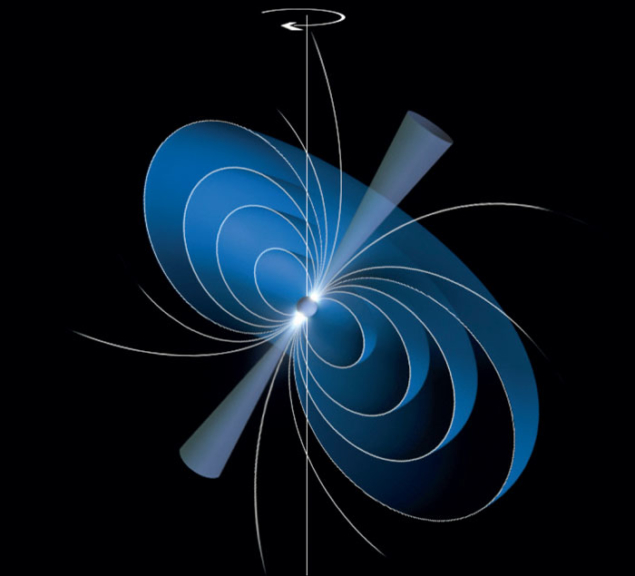Astronomers have detected simultaneous X-ray and radio-mode switches in co-ordinated observations of a pulsar. Pulsed X-ray emission is only present in states of weak radio emission. This indicates a rapid global change in the magnetosphere, which challenges current emission theories.

Image credit: ESA/ATG medialab.
Pulsars were discovered in 1967 as flickering sources of radio waves and were soon interpreted as being rotating, strongly magnetized neutron stars. The radiation is thought to be emitted by high-energy particles moving along the lines of magnetic field. As the emission is concentrated in two cones emerging from the magnetic poles, the source behaves like a lighthouse. We see a pulse each time that the radiation beam is pointed towards the Earth. This happens at the spin frequency of the neutron star because the rotation and magnetic axes are generally misaligned.
Among the thousands of known pulsars, only a small fraction has been detected in X-rays or gamma-rays (CERN Courier September 2006 p13 December 2008 p9). The X-ray emission can be steady or pulsed. The steady X-ray emission is high for young neutron stars and decreases as their surface temperature falls. The pulsed emission suggests that X-ray-emitting hot-spots are located at the magnetic poles.
Astronomers know of only a handful of old pulsars that shine in X-rays. One of them is PSR B0943+10, which is five million years old. This source also switches suddenly between a radio-bright and a radio-quiet state at intervals of several hours. It is therefore a prime target to investigate the X-ray behaviour associated with changes of the radio mode. This idea was suggested by a team led by Wim Hermsen of the Netherlands Institute for Space Research (SRON) and the Astronomical Institute “Anton Pannekoek” of the University of Amsterdam. It then took them five years to convince the time-allocation committee to schedule some long periods of observation with ESA’s X-ray Multi-Mirror Mission (XMM-Newton) satellite co-ordinated with radio telescopes.
The satellite performed six observations of six hours each on PSR B0943+10 at the end of 2011. Radio-data were gathered at the same time by the Indian Giant Metrewave Radio Telescope (GMRT) and the international Low-Frequency Array (LOFAR) in the Netherlands. The result of the campaign was completely unexpected. The X-ray emission was found not to follow the states of radio brightness. On the contrary, it was observed to be weak when the source is bright in radio emission and vice versa.
The timing and spectral analysis of the XMM-Newton data offered yet more surprises. The source was found to pulsate in X-rays only during the X-ray-bright phase corresponding to the quiet-radio state. During this phase, the X-ray emission appears to be the sum of two components: a pulsating component consisting of thermal X-rays, which is seen to switch off during the X-ray-quiet phase; and a persistent one consisting of non-thermal X-rays.
The results suggest that the entire magnetosphere around the pulsar is switching from one state to another within a few seconds. The rapidity of this change is puzzling but it is not the only issue. The observed radio and X-ray behaviour is predicted by neither of the leading models for pulsar emission.
Hermsen and his team plan to repeat the same study for another pulsar that has similar radio properties but with a different geometrical configuration. This will allow them to test whether the viewing angle with respect to the magnetic and rotational axes has an effect on the properties of the X-ray emission. In the meantime, theorists will be busy investigating possible physical mechanisms that could cause the observed sudden and drastic changes to the pulsar’s magnetosphere.








